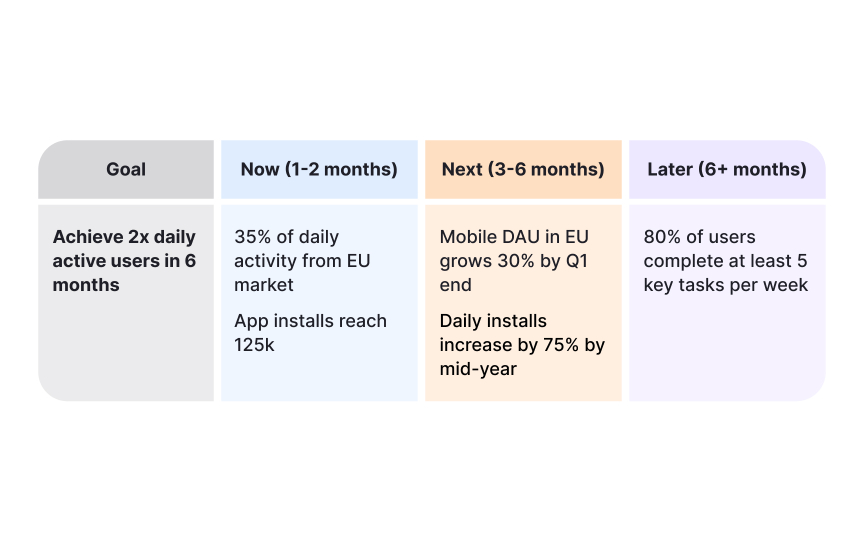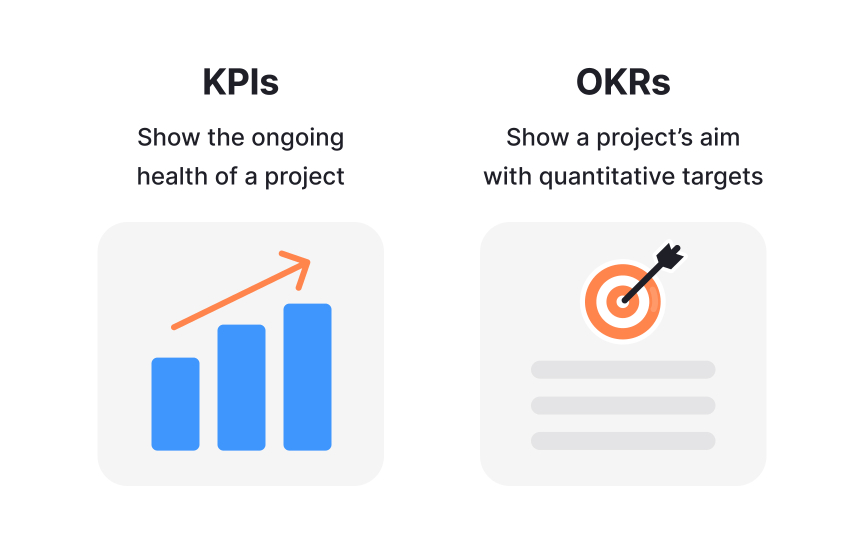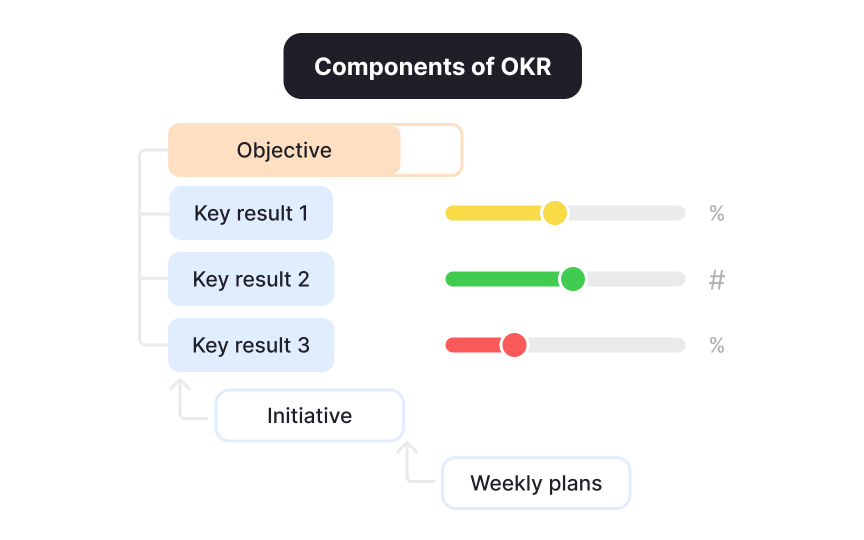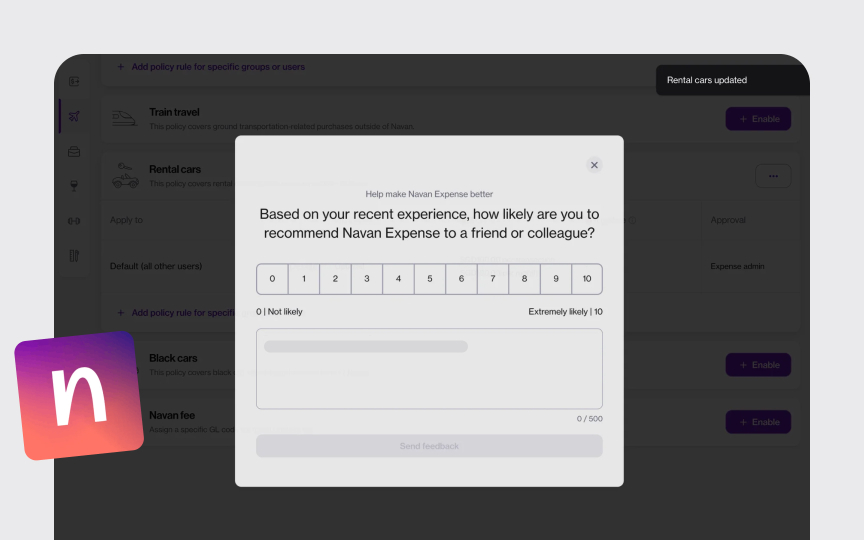Defining Success Metrics
Move from delivering outputs to achieving measurable outcomes by linking roadmaps with clear success metrics.
Success in product development is not just about launching features but about shaping outcomes that align with business goals and user value. Defining success metrics makes these outcomes visible and measurable. Metrics guide teams beyond intuition and ensure that each initiative contributes to the bigger picture.
Outcome-based roadmaps replace the feature-first mindset with a focus on solving problems and driving impact. They create accountability, promote innovation, and connect product work to strategic objectives. OKRs and KPIs play a central role here. OKRs translate aspirations into actionable results, while KPIs track long-term signals of health. Used together, they prevent teams from mistaking activity for progress.
When teams set clear metrics, link them to objectives, and review them consistently, they gain a common language for measuring progress. This clarity fosters alignment across functions, helps prioritize effectively, and turns constraints into tools for smarter decision-making. Metrics then become more than numbers. They become a strategy to define, track, and achieve success.
Releasing features can create the illusion of progress, but output does not automatically equal value. A new feature might ship on time and work as intended, yet if it fails to change user behavior or move a key business metric, its impact remains limited.
Teams that define success only by shipping features risk becoming a “feature factory,” where activity is mistaken for achievement. This often leads to misaligned priorities, as teams focus on what is easy to build or highly visible instead of what truly drives results.
By shifting attention to outcomes, product managers create accountability. Work is considered successful only when it leads to measurable improvements such as higher retention, stronger engagement, or increased revenue. When outcomes guide decisions, teams can try different solutions instead of being locked into fixed feature requests. Success is then measured by solving the right problems, not by producing the most features.[1]
Metrics are useful only when they clearly connect to the value a product is meant to deliver. A strong success metric should point directly to goals such as improving
This
Not every initiative will affect top-line metrics like revenue. Still, each should have a clear measure of impact. For example, a new onboarding survey might not raise revenue directly, but it can be successful if it increases the number of users who share feedback by 40 percent. The insights from those responses can then guide improvements that influence larger business outcomes.
Pro Tip: Select only the metrics that prove real impact, and connect each to a business goal that matters.
An outcome-based roadmap is a visual plan that organizes
Key principles include starting with product vision and business goals, then translating them into measurable outcomes. These outcomes should define what success looks like, such as increasing
Pro Tip: Anchor your roadmap in outcomes that can be measured, and let features remain flexible paths to reach them.
Outcome-based roadmaps create focus on impact, but they also come with challenges. Measuring outcomes can be difficult, especially when success depends on changes in user behavior or long-term business results. Teams may feel pressure from stakeholders who prefer fixed feature commitments because they are easier to visualize and communicate. This tension can make it harder to shift the conversation from outputs to outcomes.
Another challenge lies in setting goals that are too vague or ambitious. If outcomes are not backed by clear metrics and time frames, they risk becoming empty statements rather than actionable targets. Outcome-based planning also requires strong alignment with company strategy. Without it, teams may choose outcomes that do not support the broader business vision. Finally, success demands patience. Unlike feature delivery, which has a visible end point, outcomes require ongoing tracking and iteration. This can test team morale if progress is not made visible along the way.
Objectives and Key Results (OKRs) provide a structured way to define and track goals. An objective describes the outcome a team aims to achieve, usually in broad and qualitative terms such as improving customer satisfaction or expanding market share. Key Results make the objective measurable. They are specific, quantitative targets that show whether progress is being made. For example, an objective to enhance user engagement may include a Key Result to increase repeat visits by 20 percent within a quarter.
OKRs encourage alignment between daily work and strategic vision.
Key Performance Indicators (KPIs) are the metrics that show the ongoing health of a product or business. They act like vital signs, tracking areas such as
KPIs can also serve as Key Results within OKRs when linked to a particular outcome. For instance, a
OKRs and
- Focusing on outputs instead of outcomes. Counting shipped features does not prove value unless it reduces
churn , boostsretention , or changes user behavior. - Using vanity metrics. Numbers like page views may look good but fail to connect to the product’s North Star or strategic goals.
- Setting and forgetting. Writing OKRs once and ignoring them makes them irrelevant. They need regular updates and progress checks.
- Misalignment with company goals. Product OKRs that are not tied to broader objectives can create wasted effort.
- Top-down goal setting. Excluding input from team members leads to unrealistic or disconnected targets.
- Confusing initiatives with results. Key Results should measure effects, such as “increase engagement by 20 percent,” not actions like “launch a new dashboard.”
- Lack of accountability for KPIs. Without a clear owner, tracking becomes inconsistent and progress slips.
- Tracking too many metrics. Overloading teams with data spreads attention thin and weakens focus.
Every
There are several steps that make success definitions more effective:
- Make them measurable. Replace vague statements with targets that can be tracked.
- Keep them realistic. Ambitious goals should inspire, but they also need to be achievable within time and resource limits.
- Ensure relevance. Even if an initiative does not move headline results like
revenue , it should stilllink to a clear and traceable metric, such as feature usage or response rates. - Tie them to prioritization. When initiatives are judged against defined outcomes, it is easier to compare their potential impact and focus on the most valuable ones.[4]
By defining success in this way, teams shift the focus from delivery to value creation. This approach helps them avoid chasing “nice-to-have” features and strengthens alignment with business strategy. It also provides clarity across the team about what progress really looks like.
Pro Tip: Test each success metric with the question: does this outcome show real impact or just activity?
Metrics lose value when different teams track success in disconnected ways. One group might measure speed, another quality, and a third adoption, creating conflicting signals. Product managers play a key role in aligning these measures so they all support company-wide objectives, such as
Alignment works best when it starts with business goals and cascades down to product
By turning metrics into a common language, product managers create consistency across functions. This makes it easier to prioritize initiatives and ensures that every team’s progress contributes to the same strategic outcomes.
Pro Tip: Use company goals as the anchor so all teams’ metrics point in the same direction.
Even when metrics are aligned, they only drive results if teams feel responsible for them. Success should not rest solely on product managers. Designers, engineers, analysts, and customer success teams all shape outcomes, and each must share ownership of the metrics that define success.
Ownership begins with co-creation. Teams should be involved early when defining what success looks like and in setting realistic targets. This prevents metrics from being seen as imposed and ensures that every function understands its contribution. It also breaks silos by using insights from different perspectives, for example, customer support may highlight friction points that engineers can resolve.
When metrics are owned collectively, accountability strengthens. Teams see progress not as isolated tasks but as a joint outcome they all contribute to. This shared responsibility builds trust, increases motivation, and makes success more sustainable.
Metrics only create value if they are part of an ongoing process. A feedback loop ensures that success measures guide decisions continuously rather than becoming static reports. This loop combines data from product analytics with signals from user feedback, creating a cycle of measuring, reviewing, and adjusting.
Feedback loops can take different forms. Surveys and in-app prompts reveal user sentiment, while behavioral analytics track where people succeed or struggle. Regular check-ins across teams help interpret these signals and decide on the next actions. Without this process, metrics risk being ignored or becoming outdated.
The benefit of a strong loop is twofold: it keeps outcomes relevant as conditions change, and it makes progress visible. By showing both results and learning, feedback loops turn metrics into tools for adaptation and ongoing improvement.
References
- Outcome Based Roadmap: Step-By-Step Guide (+Best Practices) | Thoughts about Product Adoption, User Onboarding and Good UX | Userpilot Blog
Topics
From Course
Images provided by
Share
Similar lessons

Introduction to Churn Metrics and Analysis

Common Causes of Customer Churn






















